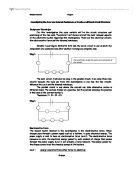Investigate methods of finding and comparing the e.m.f and internal resistance of different cells and power supplies and factors that can affect these values.
Comparson of the EMF of Cells and Power supplies
Investigate methods of finding and comparing the e.m.f and internal resistance of different cells and power supplies and factors that can affect these values.
Hypothesis
'For conductors at constant temperature, the current is proportional to the voltage across it', Ohm's law. From this it can be said that an increase in resistance should decrease the current proportionally to the voltage. The internal resistance is the gradient from the variation of voltage against current.
The power source with the greater voltage will have a greater e.m.f, because e.m.f is defined as the energy transferred to a charge, which is the same definition given to potential difference.
energy transferred
E.m.f = charge = current (external resistance + internal resistance)
Larger cells or power supplies should have greater internal resistance. This is because internal resistance is the resistance created by the chemical reactions that occur within the cells or power supplies. The larger sources will have more chemicals within it. Therefore more chemical reaction should take place.
Diagram
Power source
Ammeter
Voltmeter
Variable resistor (Resistor Box)
Method
. Set up the equipment as shown above, use a milliammeter.
2. Ensure you set resistance to highest value.
3. Record the terminal p.d and current for different value resistance.
4. Display results in a suitable form (terminal p.d against current)
Investigate methods of finding and comparing the e.m.f and internal resistance of different cells and power supplies and factors that can affect these values.
Hypothesis
'For conductors at constant temperature, the current is proportional to the voltage across it', Ohm's law. From this it can be said that an increase in resistance should decrease the current proportionally to the voltage. The internal resistance is the gradient from the variation of voltage against current.
The power source with the greater voltage will have a greater e.m.f, because e.m.f is defined as the energy transferred to a charge, which is the same definition given to potential difference.
energy transferred
E.m.f = charge = current (external resistance + internal resistance)
Larger cells or power supplies should have greater internal resistance. This is because internal resistance is the resistance created by the chemical reactions that occur within the cells or power supplies. The larger sources will have more chemicals within it. Therefore more chemical reaction should take place.
Diagram
Power source
Ammeter
Voltmeter
Variable resistor (Resistor Box)
Method
. Set up the equipment as shown above, use a milliammeter.
2. Ensure you set resistance to highest value.
3. Record the terminal p.d and current for different value resistance.
4. Display results in a suitable form (terminal p.d against current)







